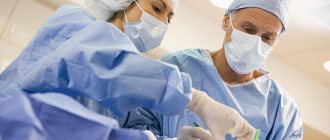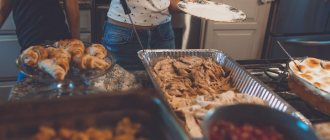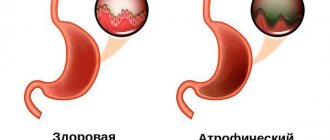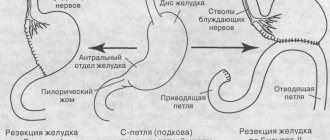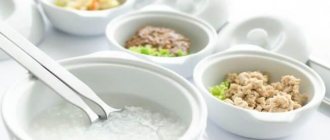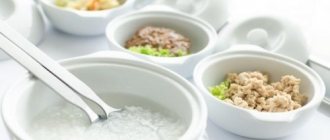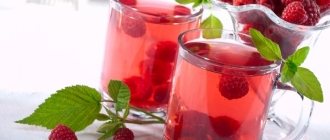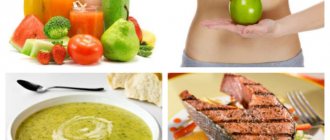Nutrition for stomach cancer can help treatment and speed up recovery, reducing the manifestations of nutritional deficiency, which is typical for patients at all stages of treatment and after its completion.
Proper nutrition for stomach cancer is more than dietary food, it is a therapeutic effect to increase the effectiveness of therapy - nutritional support.
- Proper nutrition for stomach cancer
- Recommended foods for stomach cancer
- Prohibited foods for stomach cancer
- Daily menu options
- Nutrition during and after chemotherapy for stomach cancer
- Nutrition in the early stages of stomach cancer
- Nutrition for inoperable cancer in advanced stages
- Nutrition after treatment
- Nutrition before and after stomach cancer surgery
- Preventive diet
Proper nutrition for stomach cancer
The correct diet during different periods of carcinoma development and its treatment has significant differences, so when preparing for surgery, one menu is selected, after chemotherapy, another is prescribed, and as the process progresses, a third is required. What unites the periods is the need to regularly change the dietary regimen in favor of therapeutic nutrition, that is, adjusting the menu and meal times in order to increase the effectiveness of treatment.
Therapeutic nutrition or nutritional support is not the same as dietary, when the menu is compiled based on the patient’s diseases and with an eye to maximum harmlessness in order to avoid exacerbations. The dietary regimen is always gentle and non-provoking, nutritional support is a therapeutic effect using a set of products compiled adequately to the needs of the patient and additionally saturated with elements missing from the body - proteins, vitamins, microelements.
The vast majority of patients with stomach cancer have a lack of certain nutrients - proteins and microelements; every sixth patient at the time of diagnosis is underweight, that is, has already lost weight due to the disease.
There are plenty of reasons for insufficient absorption of nutrients in the body of a stomach cancer patient:
- Impaired functioning of the stomach due to cancer infiltration of the walls, ulceration of the mucous membrane and improper production of gastric secretions, leading to inadequate absorption of nutrients and the development of metabolic disorders.
- Reduced food volume due to stomach deformation, appetite disturbances and pain, as well as removal of part or all of the organ.
- The influence of cancer on all processes in the body due to the release of aggressive substances and robbing normal cells of proteins and microelements.
- The damaging effects of treatment are adverse reactions of chemotherapy leading to loss of nutrients with vomiting and diarrhea.
- The negative impact of psychological stress accompanying diagnosis and all stages of treatment.
At different periods of tumor development and at different stages of therapy, one mechanism of nutritional deficiency may prevail or several may be combined; depending on them, the diet and its volume, the time of food intake and its constituent elements should change.
Not a single patient is able to make adequate adjustments to their menu; this requires not only blood tests, but also the knowledge of a nutritionist with experience working with cancer patients.
Menu (Power Mode)
The menu should have enough protein in the form of meat and fish dishes, vegetables and porridge. The transition from pureed to non- pureed dishes is carried out gradually. New foods should be introduced into the diet carefully, observing your feelings. During the recovery period after surgery, the digestive organs adapt to the changed conditions, so you should not load them with heavy food.
The food should be tasty and varied, since the patient has a decreased appetite and impaired taste. You should take into account his tastes and prepare your favorite dishes. It is necessary to include vegetables, fruits and juices from them, and whole grain cereals more widely in the diet.
Monday
| Breakfast |
|
| Lunch |
|
| Dinner |
|
| Afternoon snack |
|
| Dinner |
|
| For the night |
|
Tuesday
| Breakfast |
|
| Lunch |
|
| Dinner |
|
| Afternoon snack |
|
| Dinner |
|
| For the night |
|
Wednesday
| Breakfast |
|
| Lunch |
|
| Dinner |
|
| Afternoon snack |
|
| Dinner |
|
| For the night |
|
Recommended foods for stomach cancer
There is no clear understanding of the causes of the development of stomach cancer, and no cause-and-effect relationship with food consumption is seen. Modern oncology indicates the etiological influence of certain toxic substances on the development of cancer of the esophagus or intestines, but not the stomach. There are no foods that are especially beneficial for cancer patients; no specific nutritional diet has been developed for any cancer disease.
When selecting therapeutic nutrition, the patient’s initial nutritional status is taken into account: compliance with the weight standard (BMI, waist circumference), the ratio of muscles and fatty tissue, the sufficiency of blood proteins and microelements.
If there is a lack of protein, a menu with the addition of a special nutritional mixture is necessary. If there is dissonance between the protein fractions of albumin and globulin, the set of products and the type of nutritional mixture are changed. If during treatment the excretory function of the kidneys changes, then adjusting the food supply will become a vital necessity.
Proper nutrition for a patient with stomach cancer is a currently necessary and balanced food set, enriched with the missing elements from nutritional mixtures, which is what is required today to maintain strength and fight the tumor.
Features of digestion after resection
Regardless of whether an organ is completely or partially removed, the patient’s digestion process changes dramatically. It is important to adjust the diet and the functioning of the gastrointestinal tract so that the body continues to receive all the necessary substances. The patient may not feel hungry. You will have to eat on time, clearly calculating calories.
A common postoperative abnormality is dumping syndrome. By this concept, doctors mean the accelerated release of the contents of the organ stump into the intestines against the background of disturbances in the synthesis of enzymes and the nervous regulation of the digestive organs. Attacks usually begin after a meal rich in carbohydrates.
Among the signs of dumping syndrome:
- severe weakness;
- nausea;
- excessive sweating;
- vomit;
- regurgitation;
- cardiopalmus;
- diarrhea;
- drowsiness;
- dizziness.
Cancer patients who have had their stomach removed often develop intolerance to certain substances. More often:
- vitamin B12;
- Sahara;
- fats;
- lactose.
Doctors compensate for the lack of vitamins in the body by introducing them. Eating disorders are corrected by following a special diet.
Prohibited foods for stomach cancer
There is no evidence of the existence of products prohibited for cancer patients. Of course, with inflamed mucous membranes, ulcerations and inadequate production of gastric juice, you should avoid irritating foods: marinades, sauces, spices. It is advisable to eat dishes that are not spicy, not sour, not hard, without crusts and seeds. But porridge from morning to evening is not a solution to the problem, but rather aggravates it by excluding from the diet the proteins and fats necessary for building tissue.
In each period of illness, the patient needs a list of foods that are currently undesirable for consumption, changing in accordance with the nutritional status, the consequences of treatment measures, the main thing is compliance with the current condition and the urgent needs of the body. A Euroonko doctor will help you create such a list.
Reviews and results
The diet includes an extensive list of foods and different ways of processing them (except frying). Therefore, it can be diversified with new dishes. Since the food contains the physiological norm of protein and fat, it can be prescribed for a long time.
Feedback from patients indicates that therapeutic nutrition has become the norm for many people during their illness, and deviation from it immediately affects digestion. You can diversify it with new dishes, and it will not seem monotonous.
- “... Proper nutrition is the only way out for this disease after surgery to remove most of the stomach and chemotherapy. The slightest deviation or increase in portions immediately affects your health: diarrhea, bloating and abdominal discomfort. Over the course of a year, I studied my body and its reaction to food. I tolerate food well, but cooking gives my wife some trouble - I have to cook separately. I can eat something from the common table. I’m already used to steamed cutlets, it’s good that you can add dill and garlic to them - it doesn’t turn out so cloying. Sometimes I have a desire to eat smoked food, but then I feel bad”;
- “... After the operation I had to follow a therapeutic diet for a long time, probably 8 months. Now my condition is normal (I came in on time and had a successful operation), so I have expanded my diet somewhat - I can drink coffee, a piece of fried meat, and some sweets. The illness itself, the operation and dietary restrictions affected my weight - I lost 7 kg, and given my weight this is very good. I take great care of my diet and treatment so that there is no relapse”;
- “... 2 years have passed since the operation - they say this is a good time. I feel good, I started eating right and avoiding constipation, I drink a lot of water. The doctor warned me that the longer and stricter I follow the diet, the lower the risk of relapse. I’m trying really hard because I don’t want to go through everything again.”
Daily menu options
It is impossible to write out a menu for all occasions for a patient with stomach cancer; there should not be a standard list of dishes for all days, like hospital menus compiled for the week. A monotonous diet cannot be correct simply because the human body and psyche requires dietary diversity. However, there are three standard diets that take into account the nutritional needs of a certain body weight, digestive and metabolic disorders.
All options involve additional enrichment with dietary fiber, vitamins and microelements based on the individual needs of the patient. All dishes are prepared by boiling or steaming, stewing or baking, served not hot and not iced 4 to 6 times a day. The volume of nutrients and energy value, the amount of liquid and indications for prescription vary:
- An option for a patient with normal weight, without obvious metabolic and digestive disorders - physiological content of proteins, fats and carbohydrates, up to 2 liters of liquid and no more than 2400 kcal.
- The option for patients with underweight, after chemotherapy and surgery, involves a high content of proteins, fats, complex carbohydrates with a limitation of easily digestible sugar, normal fluid intake and high calorie intake - up to 3600 kcal.
- An option for disorders of metabolism and excretion of metabolites, that is, with metastases in the liver or renal disorders, after chemotherapy with platinum drugs. Protein, salt and liquid are limited, there is no place for pickles, alcohol and chocolate, but the starchiness of dishes increases with almost standard calorie content.
The list of specific dishes should be based on their nutritional value and the patient’s gastronomic preferences; eating without pleasure just for the sake of a biological need also does not help treatment, like fasting.
Sample menus for a 6-meal diet
Below are examples of a gentle diet menu for 6 meals. They provide 4 ounces (120 ml) of fluid at each meal (to prevent you from feeling full while eating) and 8 ounces (240 ml) of fluid between meals (to prevent dehydration). Remember that soup and protein shakes also count as liquids.
- Not all menu items are sugar-free. If you have diabetes, high blood sugar, or gastrointestinal syndrome: use sugar-free or “light” yogurt instead of regular yogurt;
- limit your consumption of fruit juices;
- If you drink fruit juices, dilute them with water.
- try drinking milk, cottage cheese or Lactaid ice cream;
Menu example 1
| Time | Eating | Food and drinks |
| 7:30 | Breakfast |
|
| 9:00 | Can |
|
| 10:00 | Snack |
|
| 11:30 | Can |
|
| 12:30 | Dinner |
|
| 14:00 | Can |
|
| 15:00 | Snack |
|
| 16:30 | Can |
|
| 17:30 | Dinner |
|
| 19:00 | Can |
|
| 20:00 | Snack |
|
| 21:30 | Can |
|
Menu example 2
| Time | Eating | Food and drinks |
| 7:30 | Breakfast |
|
| 9:00 | Can |
|
| 10:00 | Snack |
|
| 11:30 | Can |
|
| 12:30 | Dinner |
|
| 14:00 | Can |
|
| 15:00 | Snack |
|
| 16:30 | Can |
|
| 17:30 | Dinner |
|
| 19:00 | Can |
|
| 20:00 | Snack |
|
| 21:30 | Can |
|
Menu example 3
| Time | Eating | Food and drinks |
| 7:30 | Breakfast |
|
| 9:00 | Can |
|
| 10:00 | Snack |
|
| 11:30 | Can |
|
| 12:30 | Dinner |
|
| 14:00 | Can |
|
| 15:00 | Snack |
|
| 16:30 | Can |
|
| 17:30 | Dinner |
|
| 19:00 | Can |
|
| 20:00 | Snack |
|
| 21:30 | Can |
|
Menu example 4
| Time | Eating | Food and drinks |
| 7:30 | Breakfast |
|
| 9:00 | Can |
|
| 10:00 | Snack |
|
| 11:30 | Can |
|
| 12:30 | Dinner |
|
| 14:00 | Can |
|
| 15:00 | Snack |
|
| 16:30 | Can |
|
| 17:30 | Dinner |
|
| 19:00 | Can |
|
| 20:00 | Snack |
|
| 21:30 | Can |
|
to come back to the beginning
Nutrition during and after chemotherapy for stomach cancer
Chemotherapy for stomach cancer has become the standard of care. It is used before surgery and after the surgical stage for a total of two months, with metastasis it lasts more than 4 months. Effective drugs are toxic to the mucous membranes (fluorouracil), the nervous system (taxanes) and the kidneys (platinum derivatives).
Platinum drugs have an affinity for nervous tissue and impair renal function, causing nausea and vomiting even against the background of antiemetics. Damage to the mucous membranes of varying severity - mucositis - lasts for more than a week, significantly limiting the very possibility of nutrition, permanently and negatively changing the nutritional status of the patient.
Cancer patients tend to be underweight, and chemotherapy exacerbates cell and tissue loss. Immediately after the course and for a couple more days, due to nausea, there is no desire to eat, and on the fifth day it is no longer possible to eat due to inflammation of the mucous membranes, sometimes complications are accompanied by diarrhea.
Chemotherapy should be approached prepared so as not to aggravate nutrient deficiency and the associated protracted recovery with the addition of infections. Preparation consists of developing a long-term strategy for proper nutrition, with the possibility of adjusting the plan if complications develop.
Baby formula or cereal cannot meet the needs of an adult. The use of enriched nutritional mixtures during this period is the norm; it is important to choose the right composition and volume. A diet developed by a specialist will help improve your well-being and quickly restore damaged tissue.
Monitoring the most common problems
The following describes common problems that occur after gastrectomy surgery. Keeping a log of the foods you eat and writing down any symptoms or problems you experience will help you understand why these problems occur. You can use the form for recording the consumed foods and drinks, which is given at the end of this material.
If the tips below don't help you, talk to a clinical dietitian dietitian or your doctor.
Tips for controlling nausea
- Avoid eating heavy, spicy and fatty foods.
- Don't eat or drink too quickly. Try putting your fork down before taking another bite from your plate.
- Don't eat or drink too much at one meal.
- Do not lie horizontally after eating. Wait 2-3 hours before going to bed.
Tips for controlling overeating
- Don't eat or drink too much at one time.
- Don't drink too much liquid during meals.
- Don't eat or drink too quickly. Try putting your fork down before taking another bite from your plate. The signal that you are full reaches your brain only after 20 minutes.
- If you are having trouble switching to 6 small meals instead of 3 main meals, create a meal plan with fixed eating and drinking times.
- If you notice that your portions are back to being as large as they were before surgery, try preparing your meals in mini portions or pre-dividing them into ready-to-use portions.
- Avoid drinking carbonated drinks (such as soda and mineral water).
- Avoid vegetables that can cause gas (such as broccoli, cauliflower, cabbage, Brussels sprouts, onions, and legumes).
Tips to Prevent Diarrhea
- First of all, try to eat less sugar. Also try eating less dairy products. Lastly, don't eat a lot of fatty foods. Notice if the diarrhea goes away when you limit your intake of one of these ingredients. If so, consume such foods in smaller quantities.
- Avoid sugar alcohols such as sorbitol and mannitol. They are often found in chewing gum, candy, cough suppressants, dairy desserts, frostings, cakes and cookies. To find out if a product contains these ingredients, check its ingredients. You can use sweeteners such as NutraSweet® or Equal®.
- Try to eat foods that contain soluble fiber, such as canned fruit, bananas, peanut butter and oatmeal.
- Make sure you store food properly at home. Immediately put leftover food in the refrigerator or freezer.
- After 2 days, throw away any unused leftovers stored in the refrigerator.
- After 6 months, throw away frozen leftovers.
- Defrost leftover food in the refrigerator or microwave rather than just on the kitchen counter. Heat it to a safe temperature for consumption when the food begins to steam.
to come back to the beginning
Nutrition in the early stages of stomach cancer
Early gastric cancer is a tumor lesion within the mucous membrane and less than 2 centimeters in length, usually without ulceration. The minimal lesion is asymptomatic, in most cases it is found during preventive endoscopy or clinical examination.
During this period, disturbances in nutritional status are unlikely unless the patient has other chronic diseases, so there is no need for dietary restrictions. The menu should be based on the principles of proper nutrition, taking into account gastronomic preferences and concomitant chronic diseases.
What food to choose after chemotherapy
Chemotherapy requires preparation, maintenance and recovery of the body. The diet can be recommended by your doctor at each of these stages.
Nutrition during chemotherapy for oncology is divided into three groups based on dietary characteristics.
- Before chemotherapy.
- During chemotherapy.
- After chemotherapy treatment.
The first stage of dietary nutrition may be necessary to prepare the body for the aggressive effects of anticancer drugs. The second stage involves following dietary recommendations to maintain body function and alleviate adverse reactions. After chemotherapy, special nutrition is required to eliminate the effects of treatment, restore the condition of all organs and systems, and remove toxic substances from the body.
Recommended product groups
Eating after chemotherapy involves following a healthy diet. This means choosing energy-dense and balanced foods. At the same time, special attention is paid to diversity. Experts recommend using natural products from all food categories for cooking.
Benefits of foods by food group.
- Cereals. Must be included in a balanced diet. Grains provide the body with vitamins (group B), carbohydrates and dietary fiber, which improve the functioning of the gastrointestinal tract.
- Vegetables, herbs and fruits. An integral part of the daily diet for a healthy diet, especially after chemotherapy. Products in this group contain trace elements and essential vitamins, flavonoids and antioxidants that help restore damaged cells and regenerate new ones.
- Dairy products. Lactic acid products are considered one of the main elements of complete nutrition during chemistry. They contain lacto- and bifidobacteria, which increase the body's resistance, improve the condition and functioning of the gastrointestinal tract and reduce the intoxication effect.
- Protein. Another important group of products. It includes eggs, nuts, beans, white poultry, seafood and fish. Including them in the diet will help saturate the body with microelements, protein and vitamins.
- Oils and fats. These are not classic foods that are consumed by a healthy person. This group includes products enriched with Omega 3/6 polyunsaturated acids. They have an antitumor effect, reducing the growth of cancer cells, so their use is most important. The group includes: nuts, flaxseed, flax oil, sunflower oil, olive oil and wheat germ oil, black cumin oil, fish oil, etc.
When preparing a diet after cancer chemotherapy, the specialist takes into account not only the patient’s condition after treatment, but also the need for dietary habits in case of possible concomitant diseases.
Nutrition for inoperable cancer in advanced stages
It is a difficult time for a cancer patient, when the need of cancer cells for nutrients increases, chronic tumor intoxication deprives one of appetite, and the functions of the digestive tract organs decrease, making it impossible to satisfy the increasing demands for structural elements and energy.
The vast majority of patients develop anorexia-cachexia syndrome:
- progressive weight loss with decreased and perverted appetite - anorexia;
- insufficient food intake forces the body to take proteins from muscle tissue, causing muscle atrophy and reducing physical activity;
- the functions of all body systems decrease to the point of failure - cardiac, liver, and so on;
- a general inflammatory reaction and metabolic disorders develop.
Stages of the syndrome:
- precachexia - loss of about 5% of initial weight over six months in the presence of anorexia and inflammation;
- cachexia - large weight loss with a decrease in muscle mass and an increase in other signs of trouble;
- refractory cachexia - all symptoms have worsened so much that there is no response to treatment.
During this period, it is very important not to give up eating by mouth, that is, enteral nutrition , and always enrich the diet with nutritional mixtures. But there is a high need for intravenous administration of nutrients - parenteral nutrition . In case of gastric obstruction, a tube method of administering nutritional mixtures is used. Parenteral nutrition is more convenient and creates a state of rest in the stomach, but less proteins are absorbed, so the volumes of administered solutions are more significant than when combined with enteral nutrition. Without the participation of a nutritional support specialist in treatment, the success of treatment for anorexia-cachexia syndrome and the improvement of the patient’s well-being are not expected.
Physical education in cancer treatment
Exercise therapy is an important part of the rehabilitation of cancer patients after organ removal. Among the main tasks of gymnastics:
- stimulation of the synthesis of secretions from the digestive tract of the body;
- activation of intestinal motility;
- strengthening the abdominal muscles;
- normalization of the functioning of the respiratory and cardiovascular systems;
- developing correct posture;
- restoration of the patient's tolerance to everyday stress.
Attention: classes must be supervised by a physiotherapist.
In addition to exercise, cancer patients are advised to walk in the fresh air for at least half an hour a day. Dosed physical activity improves the functioning of the digestive system, stimulates metabolism, food absorption, and improves the patient’s mood.
Lifting heavy objects is contraindicated for patients. In the first year after removal, you cannot lift a total of more than 3 kg, then - more than 5 kg.
Nutrition after treatment
The diet after completion of therapy is determined by the body’s capabilities and losses incurred, mainly by the volume of the remaining stomach.
A sharp reduction in the stomach leads to the development of pathological syndromes, the most unpleasant of which is dumping syndrome; they try to prevent its development by modifying the operating technique. A few months after partial resection, the gastric wall will stretch and you can return to your normal routine and diet, however, weight loss is inevitable in the first 2 years due to the inability to consume adequate amounts of food and insufficient absorption.
After gastrectomy, not only a dietary, but also a therapeutic diet is necessary, strictly individual and for life.
Additional use of chemotherapy can affect the functions of other organs, in particular the liver and kidneys, which also requires drug adjustment and first therapeutic, and when the condition improves, a dietary menu that prevents exacerbations. An experienced nutritional support specialist will help you quickly overcome the consequences of treatment.
Authorized Products
- Vegetable soups are prepared using potato broth or vegetable broth with pureed vegetables and cereals. The egg-milk mixture is added to the soups and seasoned with oil. You can eat milk noodle soups, as well as puree soups with the addition of pureed meat (chicken).
- Cereals are added to soups (rice, semolina, buckwheat or oatmeal). Porridge, as an independent dish, can be cooked in milk or water, but be sure to boil it well, and whole grains are better to be pureed at first.
- At first, porridges are consumed in a semi-viscous state, and after a few months - in a crumbly state, and in the form of cereals (casseroles) with the addition of cottage cheese or vegetables. You can also use vermicelli or thin noodles for side dishes. Butter and vegetable fats are added to prepared dishes without heat treatment.
- Meat and fish are allowed only low-fat varieties. They use beef, young lamb, lean pork, chicken and turkey. Steamed and boiled dishes are prepared from meat; oven-baked dishes are also allowed (several months after a strict diet).
- At first, you need to eat boiled twisted meat, steamed cutlets, quenelles, mashed potatoes and souffles, and a little later (after a month) meatballs, zrazy and beef stroganoff (only from pre-boiled meat) and baked lump meat are introduced into the diet.
- Lean fish can be steamed or baked. It is prepared in pieces (the skin is first removed) or chopped, in the form of meatballs (cutlets, meatballs, zrazy).
- Eggs are allowed in the form of omelettes, soft-boiled and raw.
- Dairy products include milk and cream, non-acidic kefir and cottage cheese, sour cream. You can make lazy dumplings, cheesecakes and puddings from cottage cheese with a minimum percentage of fat content.
- Wheat bread, stale or dried, is allowed. You can eat crackers, dry biscuits or low-fat cookies.
- The diet must include vegetables (potatoes, beets, young peas, carrots, cauliflower); they are steamed and served as a side dish pureed (mashed potatoes, soufflé). Only pumpkin and zucchini can not be pureed. For stomach cancer, it is recommended to eat vegetables with red, yellow and orange colors (carrots, red peppers, yellow peppers, pumpkin), which contain a lot of carotenoids that have an antitumor effect.
- It is good to eat onions and garlic. The development of cancer cells is prevented by anthocyanins , which are found in eggplants, beets and red cabbage.
- It is recommended to drink juice from carrots and beets, starting with one or two spoons and increasing to one glass per day.
- Freshly squeezed juice, especially beet juice, should sit in the refrigerator for several hours before drinking. The functioning of the gastrointestinal tract is improved under the influence of beets and black radish (if tolerated), from which salads are made. For anemia, fresh pumpkin and dishes made from it are useful (up to 150 g, three times a day).
- Be sure to include citrus fruits and sea buckthorn, fruits rich in vitamin C . In early spring, it is advisable to include nettle shoots, dandelion leaves, beet tops and chard in salads. Spinach and parsley should be present on the table throughout the summer season.
- You can drink green and weak black tea with milk or cream, still water, compotes, weak coffee with milk, fruit juices, rosehip infusion and oat decoction with honey.
- Sweet desserts are prepared from pureed berries, adding semolina. Sweet berries and fruits are first consumed boiled; they are used to prepare jelly, puree, jelly and sambuca. If well tolerated, fresh fruits and berries are introduced.
- Meringues, marmalade, non-sour jam, marshmallows, marshmallows and honey are allowed as desserts.
Table of permitted products
| Proteins, g | Fats, g | Carbohydrates, g | Calories, kcal | |
Vegetables and greens | ||||
| zucchini | 0,6 | 0,3 | 4,6 | 24 |
| cauliflower | 2,5 | 0,3 | 5,4 | 30 |
| potato | 2,0 | 0,4 | 18,1 | 80 |
| carrot | 1,3 | 0,1 | 6,9 | 32 |
| beet | 1,5 | 0,1 | 8,8 | 40 |
| pumpkin | 1,3 | 0,3 | 7,7 | 28 |
Fruits | ||||
| apricots | 0,9 | 0,1 | 10,8 | 41 |
| watermelon | 0,6 | 0,1 | 5,8 | 25 |
| bananas | 1,5 | 0,2 | 21,8 | 95 |
| melon | 0,6 | 0,3 | 7,4 | 33 |
| nectarine | 0,9 | 0,2 | 11,8 | 48 |
| peaches | 0,9 | 0,1 | 11,3 | 46 |
| apples | 0,4 | 0,4 | 9,8 | 47 |
Berries | ||||
| strawberry | 0,8 | 0,4 | 7,5 | 41 |
| raspberries | 0,8 | 0,5 | 8,3 | 46 |
Cereals and porridges | ||||
| buckwheat (kernel) | 12,6 | 3,3 | 62,1 | 313 |
| semolina | 10,3 | 1,0 | 73,3 | 328 |
| cereals | 11,9 | 7,2 | 69,3 | 366 |
| white rice | 6,7 | 0,7 | 78,9 | 344 |
Flour and pasta | ||||
| noodles | 12,0 | 3,7 | 60,1 | 322 |
Bakery products | ||||
| white bread crackers | 11,2 | 1,4 | 72,2 | 331 |
Confectionery | ||||
| jam | 0,3 | 0,2 | 63,0 | 263 |
| jelly | 2,7 | 0,0 | 17,9 | 79 |
| marshmallows | 0,8 | 0,0 | 78,5 | 304 |
| meringues | 2,6 | 20,8 | 60,5 | 440 |
| paste | 0,5 | 0,0 | 80,8 | 310 |
| Maria cookies | 8,7 | 8,8 | 70,9 | 400 |
Raw materials and seasonings | ||||
| honey | 0,8 | 0,0 | 81,5 | 329 |
| sugar | 0,0 | 0,0 | 99,7 | 398 |
| milk sauce | 2,0 | 7,1 | 5,2 | 84 |
Dairy | ||||
| milk | 3,2 | 3,6 | 4,8 | 64 |
| kefir | 3,4 | 2,0 | 4,7 | 51 |
| cream | 2,8 | 20,0 | 3,7 | 205 |
| sour cream | 2,8 | 20,0 | 3,2 | 206 |
| curdled milk | 2,9 | 2,5 | 4,1 | 53 |
Cheeses and cottage cheese | ||||
| cottage cheese | 17,2 | 5,0 | 1,8 | 121 |
Meat products | ||||
| boiled beef | 25,8 | 16,8 | 0,0 | 254 |
| beef liver | 17,4 | 3,1 | 0,0 | 98 |
| boiled beef tongue | 23,9 | 15,0 | 0,0 | 231 |
| boiled veal | 30,7 | 0,9 | 0,0 | 131 |
| rabbit | 21,0 | 8,0 | 0,0 | 156 |
Bird | ||||
| boiled chicken | 25,2 | 7,4 | 0,0 | 170 |
| turkey | 19,2 | 0,7 | 0,0 | 84 |
Eggs | ||||
| chicken eggs | 12,7 | 10,9 | 0,7 | 157 |
Fish and seafood | ||||
| black caviar | 28,0 | 9,7 | 0,0 | 203 |
| salmon caviar granular | 32,0 | 15,0 | 0,0 | 263 |
Oils and fats | ||||
| butter | 0,5 | 82,5 | 0,8 | 748 |
| ghee | 0,2 | 99,0 | 0,0 | 892 |
Non-alcoholic drinks | ||||
| mineral water | 0,0 | 0,0 | 0,0 | — |
| black tea with milk and sugar | 0,7 | 0,8 | 8,2 | 43 |
Juices and compotes | ||||
| apricot juice | 0,9 | 0,1 | 9,0 | 38 |
| carrot juice | 1,1 | 0,1 | 6,4 | 28 |
| pumpkin juice | 0,0 | 0,0 | 9,0 | 38 |
| * data is per 100 g of product | ||||
Nutrition before and after stomach cancer surgery
Surgery is stressful for the body, especially for gastrointestinal cancer; the consequences are more severe when several weeks of preoperative chemotherapy are performed.
A patient with a pronounced decrease in nutritional status is not subject to surgical treatment. Therefore, over the course of a week or two, he is actively prepared for surgery with intravenous administration of nutritional solutions and enrichment of meals with nutritional mixtures, and only when protein metabolism indicators are restored is he taken for surgery. High-quality preoperative nutritional preparation can reduce the likelihood of complications and speed up the patient’s recovery.
After surgery, the body’s need for “building materials” and energy sharply increases, so the tactics of as early as possible postoperative nutrition with enriched mixtures have been adopted. If there is an initial violation of the nutritional status, already 6 hours after the operation they resort to the introduction of mixtures through a tube, and a day later the patient’s menu is expanded with additional volumes of mixtures. Sometimes it is possible to avoid probing if the patient drinks mixtures on his own and is able to swallow in the first 12 hours after the intervention. Normally, by the end of the week the patient is able to eat independently.
The duration and “aggression” of postoperative nutritional support depends on the volume of intervention, the initial condition and concomitant diseases of the patient.
The therapeutic diet is completed with an increase in weight and volume of muscle mass, normal biochemistry of proteins and microelements, absence of anemia and restoration of motor activity.
Fighting dumping syndrome
Dumping syndrome is a specific nutritional problem that occurs after removal of the stomach. It is associated with food entering the small intestine too quickly.
The main manifestations of the syndrome are weakness, dizziness, palpitations immediately or some time after eating.
To reduce unpleasant symptoms, follow the following dietary rules:
- The amount of simple carbohydrates (sugar, confectionery) is sharply limited, up to complete exclusion.
- Liquid sweet dishes and drinks (milk porridge, tea with sugar, etc.) are excluded from the diet.
- Carbohydrates should mainly be represented by cereals, vegetables, fruits - depending on tolerance.
- Eat often and in small portions.
- It is better to consume liquid separately from solid food (after 30 minutes).
- If symptoms are severe, during lunch, eat the second dish first, then the first.
- After eating, it is better to lie down for a while or relax reclining in a chair.
Preventive diet
It has been proven that a healthy and varied diet, quitting smoking, and maintaining a normal weight along with regular physical activity help prevent cancer. There are no foods that definitely lead to malignant processes, but adequate consumption of fruits and vegetables rich in vitamins and microelements while limiting “dark” animal meat helps maintain health. This is a good prevention of malignant processes in the stomach.
Contact a Euroonco specialist to find out how to increase the effectiveness of antitumor treatment, as well as what diet is indicated specifically in your case.
Book a consultation 24 hours a day
+7+7+78
Bibliography:
- Obukhova O.A., Bagrova S.G., Besova N.S. et al. /Assessment of the nutritional status of patients with inoperable gastric cancer at the time of initiation of antitumor treatment. Preliminary results of a prospective observational study // Difficult patient; 2018; 6.
- Potapov A.L., Dorozhkin A.D., Gamayunov S.V. and others /Perioperative nutritional support for gastric cancer: current state of the issue// Siberian Journal of Oncology; 2019; 18(6).
- Snegova A.V., Kononenko I.B., Larionova V.B. and others/Anorexia-cachexia syndrome in cancer patients//Clinical oncohematology; 2015; 2.
- Khomichuk A.L. /Optimization of nutrition for patients after gastrectomy// Questions of dietetics; 2013.
- Fukuda Y., Yamamoto K., Hirao M., et al./Prevalence of Malnutrition Among Gastric Cancer Patients Undergoing Gastrectomy and Optimal Preoperative Nutritional Support for Preventing Surgical Site Infections//Ann Surg Oncol.; Dec 2015; 22 Suppl 3.
- Weimann A., Braga M., Carli F., et al./ ESPEN guideline: Clinical nutrition in surgery // Clin Nutr.; 2022 Jun; 36(3).
Fully or partially limited products
- Rich meat, fish and mushroom broths (first 2 months). Then it is possible to use secondary meat broths.
- At first, vegetables rich in fiber (radish, turnip, beans, peas, rutabaga, fruits with peel) and meat with cartilage, veins and skin are completely excluded.
- Hot spices and sauces with preservatives.
- The following meat products are prohibited: fatty pork, duck, lamb, goose, canned meat and smoked meats.
- Salty foods, smoked meat and fish products.
- The consumption of pickled and pickled vegetables, canned vegetables, which cause increased secretion, is prohibited. You should not eat meat sauces, tomato sauce, horseradish, mustard, or pepper that irritate the mucous membranes. The exception is garlic.
- Millet, pearl barley, barley and corn cereals are difficult to digest, so they are excluded from the diet for a long time.
- Unripe fruits and vegetables.
- Coffee, strong tea, carbonated drinks, alcohol in any form.
- Various semi-finished products and animal fats.
- Fried and hard-boiled eggs are poorly digestible, so it is not recommended to consume them in this form.
- Any fresh bread, butter and puff pastry, dried fruits, chocolate and ice cream are prohibited, since excessive amounts of sugar enhance putrefactive processes.
Table of prohibited products
| Proteins, g | Fats, g | Carbohydrates, g | Calories, kcal | |
Vegetables and greens | ||||
| vegetables legumes | 9,1 | 1,6 | 27,0 | 168 |
| swede | 1,2 | 0,1 | 7,7 | 37 |
| cabbage | 1,8 | 0,1 | 4,7 | 27 |
| sauerkraut | 1,8 | 0,1 | 4,4 | 19 |
| green onion | 1,3 | 0,0 | 4,6 | 19 |
| bulb onions | 1,4 | 0,0 | 10,4 | 41 |
| cucumbers | 0,8 | 0,1 | 2,8 | 15 |
| canned cucumbers | 2,8 | 0,0 | 1,3 | 16 |
| white radish | 1,4 | 0,0 | 4,1 | 21 |
| turnip | 1,5 | 0,1 | 6,2 | 30 |
| canned tomatoes | 1,1 | 0,1 | 3,5 | 20 |
| horseradish | 3,2 | 0,4 | 10,5 | 56 |
| spinach | 2,9 | 0,3 | 2,0 | 22 |
| sorrel | 1,5 | 0,3 | 2,9 | 19 |
Mushrooms | ||||
| mushrooms | 3,5 | 2,0 | 2,5 | 30 |
Cereals and porridges | ||||
| corn grits | 8,3 | 1,2 | 75,0 | 337 |
| pearl barley | 9,3 | 1,1 | 73,7 | 320 |
| millet cereal | 11,5 | 3,3 | 69,3 | 348 |
| barley grits | 10,4 | 1,3 | 66,3 | 324 |
Confectionery | ||||
| candies | 4,3 | 19,8 | 67,5 | 453 |
| pastry cream | 0,2 | 26,0 | 16,5 | 300 |
Ice cream | ||||
| ice cream | 3,7 | 6,9 | 22,1 | 189 |
Cakes | ||||
| cake | 4,4 | 23,4 | 45,2 | 407 |
Raw materials and seasonings | ||||
| mustard | 5,7 | 6,4 | 22,0 | 162 |
| ginger | 1,8 | 0,8 | 15,8 | 80 |
| ketchup | 1,8 | 1,0 | 22,2 | 93 |
| mayonnaise | 2,4 | 67,0 | 3,9 | 627 |
| ground black pepper | 10,4 | 3,3 | 38,7 | 251 |
| chilli | 2,0 | 0,2 | 9,5 | 40 |
Meat products | ||||
| pork | 16,0 | 21,6 | 0,0 | 259 |
| ham | 22,6 | 20,9 | 0,0 | 279 |
Sausages | ||||
| dry-cured sausage | 24,1 | 38,3 | 1,0 | 455 |
| sausages | 10,1 | 31,6 | 1,9 | 332 |
| sausages | 12,3 | 25,3 | 0,0 | 277 |
Bird | ||||
| smoked chicken | 27,5 | 8,2 | 0,0 | 184 |
| duck | 16,5 | 61,2 | 0,0 | 346 |
| smoked duck | 19,0 | 28,4 | 0,0 | 337 |
| goose | 16,1 | 33,3 | 0,0 | 364 |
Fish and seafood | ||||
| dried fish | 17,5 | 4,6 | 0,0 | 139 |
| smoked fish | 26,8 | 9,9 | 0,0 | 196 |
| canned fish | 17,5 | 2,0 | 0,0 | 88 |
Oils and fats | ||||
| animal fat | 0,0 | 99,7 | 0,0 | 897 |
| cooking fat | 0,0 | 99,7 | 0,0 | 897 |
Non-alcoholic drinks | ||||
| bread kvass | 0,2 | 0,0 | 5,2 | 27 |
| * data is per 100 g of product | ||||
Is it possible to eat before chemotherapy?
To make it easier for the body to tolerate chemotherapy, it is necessary to prepare the body for the load. In addition to treating existing diseases (if possible), taking prescribed medications and other measures that are indicated by the doctor as the most important, diet should be adjusted.
Diet features are determined individually. In most cases, oncologists advise eliminating “heavy” foods, alcohol and a number of harmful foods 1–2 weeks before chemotherapy. Also, to improve all clinical indicators, it is recommended to eat foods containing large amounts of microelements and vitamins.
A pressing question for cancer patients is whether to eat before chemotherapy or not? On the day of the procedure, you need to have breakfast, but not too much and the food should be easily digestible. The day before chemotherapy and on the day it is performed, it is advisable to take a large amount of water.
